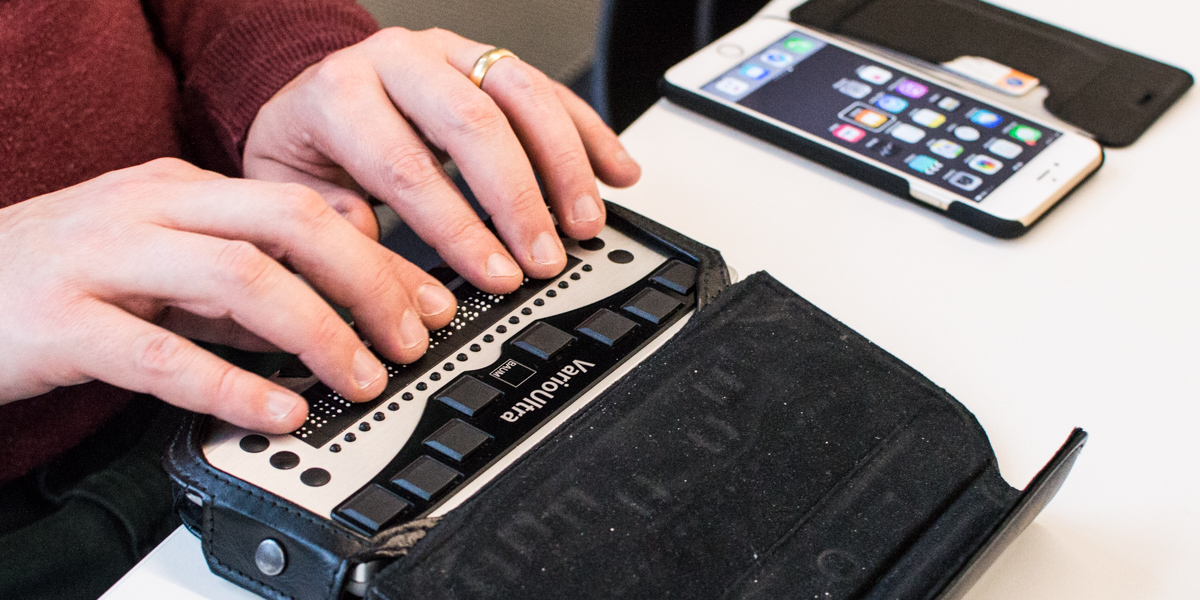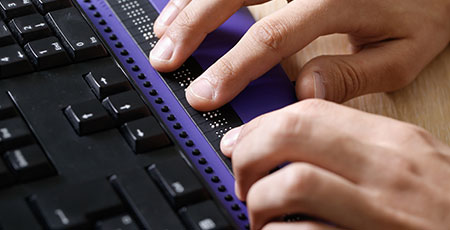Enhance Accessibility with Braille Devices and Notetakers
Enhance Accessibility with Braille Devices and Notetakers
Blog Article
Discover Cutting-edge Devices Created for the Visually Impaired
The advancement of innovative tools for the visually damaged stands for a substantial innovation in availability and freedom. Technologies such as clever glasses with AI abilities and mobile applications made to supply acoustic summaries are improving daily experiences for users. In addition, wearable devices that employ haptic responses improve environmental recognition, while modern Braille developments supply new ways to engage with message. As these tools remain to develop, their effect on the lives of those with aesthetic disabilities raises important concerns concerning the future of inclusivity and autonomy in different facets of life. What exists in advance in this technical landscape?
Smart Glasses for Navigating

Smart glasses designed for navigating are transforming the method visually impaired people communicate with their setting. These innovative tools make use of a combination of cam modern technology, fabricated intelligence, and auditory responses to supply real-time details about surroundings. By utilizing challenge detection systems, clever glasses can signal users to potential threats, enabling more secure wheelchair in both unknown and familiar setups.
The combination of GPS modern technology even more boosts navigation capacities, allowing users to receive auditory directions as they move. This hands-free technique not only cultivates independence but also encourages visually damaged individuals to browse city landscapes with enhanced self-confidence. Furthermore, several clever glasses are geared up with features that determine landmarks and road indications, providing contextual info that boosts the individual experience.
Furthermore, the growth of these gadgets is constantly progressing, with firms functioning to improve the precision of object acknowledgment and broaden the array of navigational functions. As smart glasses come to be a lot more available and economical, they hold the potential to considerably change every day life for visually damaged individuals. Ultimately, these cutting-edge tools represent an essential step towards inclusivity, offering improved movement and a better feeling of autonomy for individuals navigating the globe around them.

Mobile Apps for Daily Living
Exactly how can mobile applications enhance the everyday lives of visually impaired individuals? Mobile applications are revolutionizing the way visually impaired customers navigate their atmospheres, manage day-to-day jobs, and access information. These applications supply vital assistance through different functionalities, promoting independence and boosting lifestyle.
A number of ingenious mobile applications are created particularly for daily living. Applications like Be My Eyes attach visually impaired individuals with sighted volunteers by means of video clip telephone calls, allowing them to get real-time aid with jobs such as checking out labels or navigating unknown rooms. Likewise, Seeing AI, developed by Microsoft, utilizes fabricated intelligence to define environments, reviewed text, and determine things, properly changing a mobile phone into an effective device for everyday help.
In addition, navigation apps customized for the aesthetically damaged, such as Aira and BlindSquare, offer audio-based directions and environmental details, making it possible for users to traverse their environments securely and with confidence. Beyond navigation and immediate aid, mobile applications also sustain company and task management, with attributes that aid individuals establish suggestions, develop to-do checklists, and track appointments. In summary, mobile applications work as important resources, empowering visually impaired individuals to lead more independent and meeting lives.
Wearable Technologies for Aid
Empowerment through modern technology is increasingly obvious in the world of wearable tools made to assist visually impaired people. These innovative devices integrate effortlessly right into life, improving navigation and providing necessary feedback to users. Smart glasses furnished with video cameras can recognize faces and read text out loud, permitting customers to communicate even more with confidence in expert and social setups.
Another significant innovation is making use of haptic feedback systems in wearable tools. These systems utilize vibrations or other tactile signals to communicate details regarding the customer's atmosphere, such as challenges or changes in surface, improving mobility and security. Wearable technologies likewise consist of wristbands that connect to smartphones, notifying customers to alerts with subtle vibrations, hence boosting connectivity without dependence on aesthetic hints.
As these modern technologies proceed to develop, they are not just enhancing freedom for visually damaged individuals yet likewise cultivating a better sense of incorporation in culture. By bridging the space in between difficulties dealt with in everyday living and the capacity for freedom, wearable modern technologies function as critical tools in the mission for equal rights and empowerment for those with visual disabilities.
Sound Description Devices
Sound description tools play an important role in boosting ease of access for aesthetically impaired people, offering them with the capacity to involve with aesthetic media. informative post OCR devices for the blind. These devices use narrated summaries of vital visual components in films, tv shows, and live efficiencies, making certain that customers can fully understand the context and emotions conveyed with visuals
Audio description can be incorporated into numerous platforms, including streaming solutions, cinema screenings, and live movie theater. Numerous prominent streaming services now include audio description as an access attribute, allowing customers to select it easily. In addition to traditional media, specialized apps likewise exist, giving audio descriptions for art exhibitions, museums, and other social events.
The performance of audio description pivots on the ability of the storytellers, that have to share visual details succinctly without detracting from the initial audio. Developments in this field are also leading the way for more individualized experiences, where individuals can change the level of detail and pacing according to their choices.
Braille Innovations and Instruments
Braille devices and technologies have actually considerably transformed the method aesthetically damaged individuals connect with message and info. Modern advancements have brought about the advancement of versatile devices that enhance proficiency and independence amongst customers. Significantly, Braille show innovations have progressed, permitting vibrant analysis experiences. These gadgets convert electronic text into Braille, enabling individuals to access a vast variety of info on computer systems, tablets, and mobile phones.
In addition, mobile Braille notetakers incorporate conventional Braille input with contemporary functionalities, facilitating note-taking, scheduling, and record editing and enhancing on the go. Speech-to-text devices for low vision. These small tools frequently feature text-to-speech capacities, linking the void in between Braille and auditory information
On top of that, ingenious Braille printers have emerged, allowing users to produce Braille tags, documents, and instructional materials effectively. This accessibility fosters better participation in instructional and expert settings, eventually advertising inclusivity.
In addition, research into smart Braille technologies remains to expand. Devices that integrate expert system are being explored to provide real-time navigation aid and contextual info, improving the customer experience in Learn More varied settings. In general, these advancements reflect a dedication to encouraging visually damaged individuals with modern technology, ensuring they can quickly gain access to and engage with the globe around them.

Verdict
The development of ingenious devices for the visually damaged significantly improves independence and quality of life. Smart glasses, mobile applications, wearable innovations, audio description devices, and Braille innovations collectively equip people by offering crucial navigating help, ecological recognition, and improved reading experiences. These innovations not just foster greater incorporation yet likewise promote freedom in daily tasks, eventually adding to a more check equitable and easily accessible culture for aesthetically impaired people. Proceeded development in this field holds pledge for additional improvements.
As wise glasses end up being much more obtainable and economical, they hold the possible to considerably transform daily life for aesthetically impaired individuals. Mobile applications are reinventing the means visually damaged individuals navigate their settings, manage everyday tasks, and access details. Applications like Be My Eyes attach visually damaged individuals with sighted volunteers by means of video telephone calls, enabling them to receive real-time aid with jobs such as reviewing tags or browsing unknown rooms.In addition, navigation apps customized for the aesthetically impaired, such as Aira and BlindSquare, use audio-based directions and ecological info, allowing individuals to traverse their surroundings securely and confidently.The development of innovative devices for the aesthetically impaired substantially boosts freedom and high quality of life.
Report this page